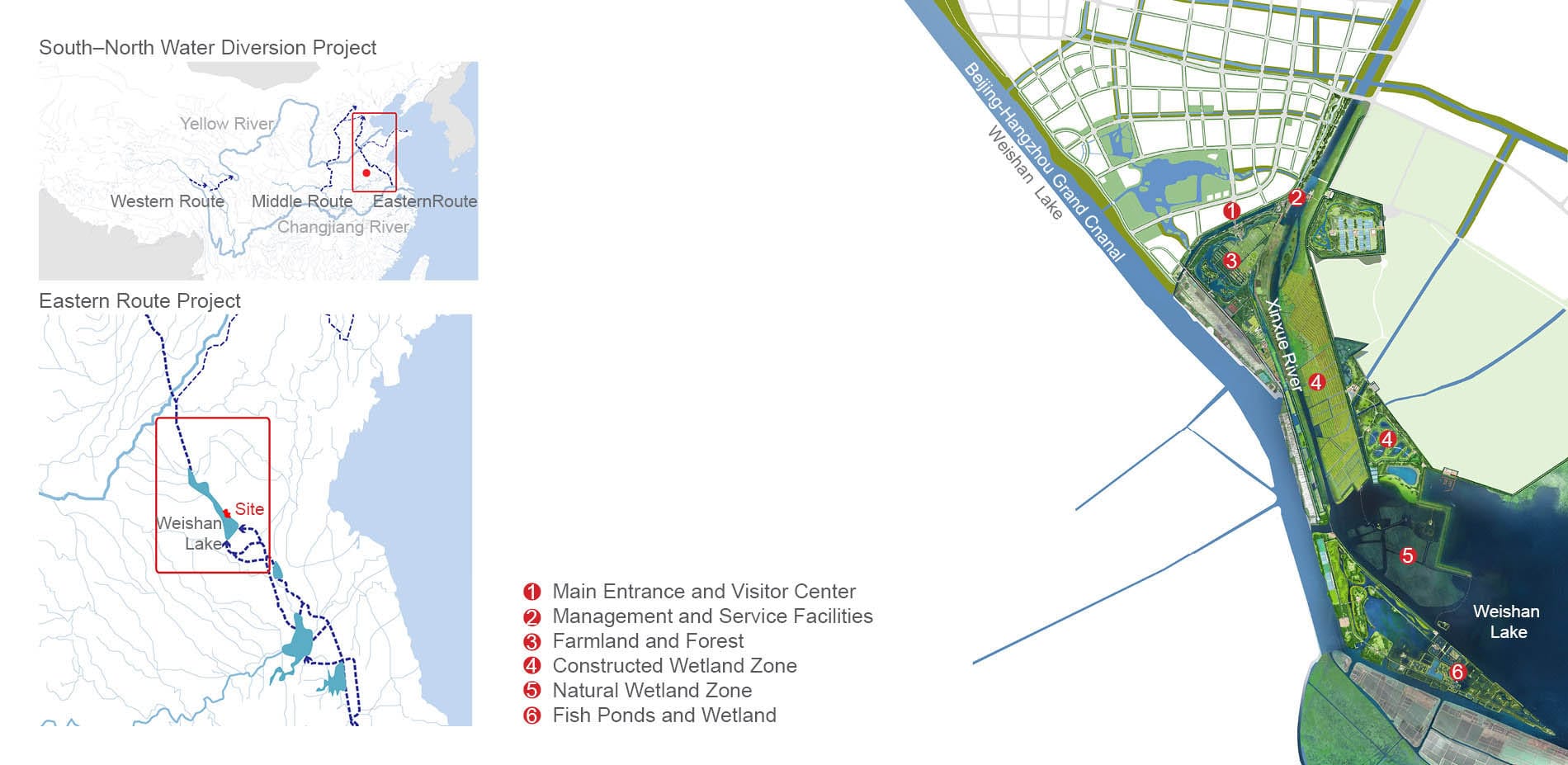
Site Plan and Location Plan.
Photo Credit: Zhao Jie (AECOM), Scott Burrows (Consultant), Wei Shan Photography Association
Media: Please submit high-resolution image requests to images@asla.org.
The original site boasts abundant natural resources but landscape character is relatively indistinct. Ecological and environmental conditions were relatively undisturbed, but agricultural activities has caused significant environmental pollution in some areas.
Photo Credit:Zhao Jie (AECOM), Scott Burrows (Consultant), Wei Shan Photography Association
Media: Please submit high-resolution image requests to images@asla.org.
Water Treatment & Educational Wetland System
Photo Credit: Zhao Jie (AECOM), Scott Burrows (Consultant), Wei Shan Photography Association
Media: Please submit high-resolution image requests to images@asla.org.
After treatment by through constructed wetlands, water flows back into Weishan Lake, famous for its lotus plants.
Photo Credit: Zhao Jie (AECOM), Scott Burrows (Consultant), Wei Shan Photography Association
Media: Please submit high-resolution image requests to images@asla.org.
A selection of local wetland plants are used in different areas to improve quality of water from the water diversion, creating a sustainable and healthy lake habitat.
Photo Credit: Zhao Jie (AECOM), Scott Burrows (Consultant), Wei Shan Photography Association
Media: Please submit high-resolution image requests to images@asla.org.
To create seasonal landscape features through the use of tiering and diverse variety of planting. By increasing the types of local flora and fauna, the site is restored into a robust diverse landscape suitable for outdoor science education.
Photo Credit: Zhao Jie (AECOM), Scott Burrows (Consultant), Wei Shan Photography Association
Media: Please submit high-resolution image requests to images@asla.org.
The completed wetlands covers 200 Hectares. At peak efficiency, COD (chemical oxygen demand) removal rate is estimated at 50%, total phosphorus removal rate approximately 60%, and ammonia removal efficiency is up to 65%.
Photo Credit: Zhao Jie (AECOM), Scott Burrows (Consultant), Wei Shan Photography Association
Media: Please submit high-resolution image requests to images@asla.org.
The bird viewing corridor is designed to blend into its surroundings, and to reduce impact of pedestrian traffic on bird habitat and activity.
Photo Credit: Zhao Jie (AECOM), Scott Burrows (Consultant), Wei Shan Photography Association
Media: Please submit high-resolution image requests to images@asla.org.
A network of timber boardwalks and viewing platforms weaves across the site, providing ample opportunities for diverse landscape experiences through reed beds and poplar groves.
Photo Credit: Zhao Jie (AECOM), Scott Burrows (Consultant), Wei Shan Photography Association
Media: Please submit high-resolution image requests to images@asla.org.
The timber decks are constructed out of locally sourced materials, as part of the project’s low-impact design strategy.
Photo Credit: Zhao Jie (AECOM), Scott Burrows (Consultant), Wei Shan Photography Association
Media: Please submit high-resolution image requests to images@asla.org.
With improved water quality, people are now able to swim in the lake.
Photo Credit: Zhao Jie (AECOM), Scott Burrows (Consultant), Wei Shan Photography Association
Media: Please submit high-resolution image requests to images@asla.org.
Green energy, such as solar and wind power, is used to power park services and facilities, including scientific monitoring utilities.
Photo Credit: Zhao Jie (AECOM), Scott Burrows (Consultant), Wei Shan Photography Association
Media: Please submit high-resolution image requests to images@asla.org.
Weishan’s lotus is both culturally and economically significant to the local area. This specially commissioned contemporary sculpture marks the entrance of the park.
Photo Credit: Zhao Jie (AECOM), Scott Burrows (Consultant), Wei Shan Photography Association
Media: Please submit high-resolution image requests to images@asla.org.
The organic revetment that required reconstruction is made of on-site wickers and poplar timber piles. Wickers woven around the timber piles will sprout the following spring, firmly consolidating and stabilizing the soil mass around them.
Photo Credit: Zhao Jie (AECOM), Scott Burrows (Consultant), Wei Shan Photography Association
Media: Please submit high-resolution image requests to images@asla.org.
After treatment by artificial wetlands, water in the lake is suitable for recreation.
Photo Credit: JZhao Jie (AECOM), Scott Burrows (Consultant), Wei Shan Photography Association
Media: Please submit high-resolution image requests to images@asla.org.


















